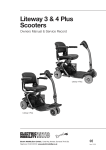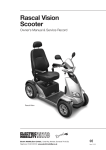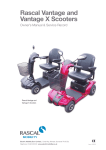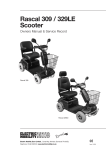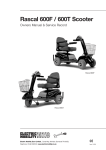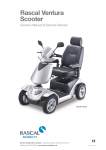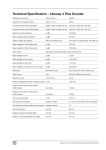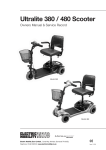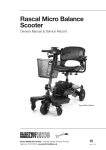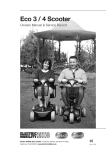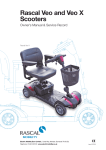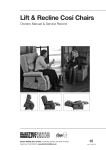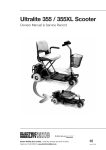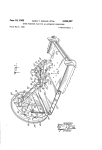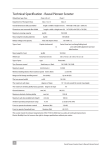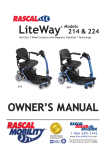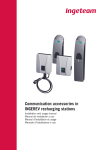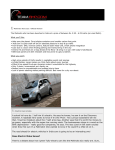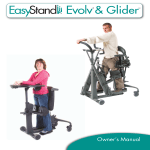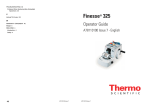Download EME Owners Manual Eco 3 4
Transcript
Liteway Balance Liteway Balance Plus Scooters Owners Manual & Service Record Liteway Balance Liteway Balance Plus Electric Mobility Euro Limited, Canal Way, Ilminster, Somerset TA19 9DL Telephone: 01460 258100 www.electricmobility.co.uk Issue 2: 03/11 Liteway Balance Liteway Balance Plus Electric Mobility Euro Ltd offers these lightweight, manoeuvrable scooters for convenient indoor and outdoor use. The Liteway Balance Plus split-frame scooter can be easily and quickly dismantled for transportation in the boot of a car, whereas the Liteway Balance is a fixed frame unit but similar in all other respects. Provided that your scooter is maintained and operated in accordance with this manual it should last for many years, and provide you with freedom and independence. Please read this manual thoroughly before using this scooter. If you have any doubts about warnings or instructions, ask your dealer for an explanation. If at any time you feel you may not be able to control the vehicle safely, do not drive, but consult your dealer for a solution. If you think the scooter may be damaged, do not drive it but contact your dealer for advice. We suggest that you keep this manual in a safe place. It contains essential information on the operation of the scooter and includes the maintenance records. If at any time you feel you may not be able to control the vehicle safely, do not drive, but consult your dealer for a solution. Notice All Electric Mobility Vehicles are sold through authorised dealers. Make sure your dealer demonstrates all the features of the product prior to, or when, it is delivered. Warning! This manual contains important safety notices. Please take time to read and understand them. Ignoring them may endanger you or others. 2 2 Liteway Balance & Liteway Balance Plus Scooters Owner's Manual and Service Record Contents Dealer information 4 Features and layout 4 Safety information 5 Intended use 5 Safety Information 6 Controls 8 Freewheel Device 9 Brakes 9 Armrest adjustment 10 Swivel seat (optional) 10 Tiller folding 10 Transferring in and out of your scooter. 11 Operation 12 Driving the vehicle 12 Driving the vehicle - hazards 13 Transporting your scooter 14 Assembling your scooter 16 Battery charging 17 User maintenance 19 Servicing & maintenance 19 Scooter Diagnostic Functions 20 Troubleshooting guide 21 Additional safety information 21 Additional information 22 Frequently asked questions 22 Engineers checklist 23 Guarantee & Warranty 24 Technical information regarding EMI 24 Technical specification - Liteway Balance Plus 25 Technical specification - Liteway Balance 26 Brochure request 27 Warranty Card - dealer information 27 Service log 29 3 Dealer Information This is your contact number for service and support Dealer Stamp Product Model Number Serial Number Date of Purchase Owner Telephone: Email: For product information see serial number plate on the seat post under the seat. Manufacturer Electric Mobility Euro Limited Canal Way, Ilminster, Somerset TA19 9DL Company Registration in England No. 2419231 Features and Layout Photo shows Liteway Balance Plus model scooter. The Liteway Balance is a fixed-frame version. See the specification for the description of any differences. Finger control lever Fold down backrest Tiller adjustment Fold up / adjustable armrests Charging cable Battery box Freewheel lever Solid tyres all round Magnetic Stabiliser Wheels™ 4 Under seat storage basket Liteway Balance & Liteway Balance Plus Scooters Owner's Manual and Service Record Safety Information Read this manual thoroughly before driving or operating the vehicle. This handbook is applicable for all models. If you have any doubt about the content of this manual phone your dealer to resolve the problem. Please read this manual, and ensure your scooter is serviced regularly. Within this manual there are important safety notices. They are clearly marked with the sign (left) Make sure that you understand all these notices. If you have any doubt, contact your dealer. Book symbol: This symbol appears on the product. Please read this product manual before assembling or operating the scooter. Pinchpoint symbol: Wherever you see this sign there is a nearby risk of injury owing to a pinch or crushing point. Tip symbol: This sign indicates advice on how to get the most from your scooter. © 2011 Electric Mobility Euro Ltd. No liability is assumed with respect to the use of any information contained in this publication. While every precaution has been taken in the preparation of this publication Electric Mobility Euro Ltd. assumes no responsibility for errors or omissions nor is any liability assumed for damages resulting from the use of information contained in this publication. This publication, as well as the operational details described herein, is subject to change without notice. Intended use of the vehicle This vehicle is designed for use by adults with a disability (up to the maximum recommended weight - see Technical Specification sheet) who require a robust but lightweight and transportable scooter that is ideal for both indoor and outdoor use as well as shopping and other visits. Liteway Scooters have been specifically designed to be disassembled for transportation by car. These scooters are intended for use in the home, shopping areas and trips on paved surfaces. Kerbs should be avoided, but the scooters can mount kerbs and small obstacles up to that specified in the Technical Specification sheet. Users could endanger themselves and others if they are not capable of driving this scooter safely. Dealers will advise on the most suitable vehicle from the Electric Mobility range, but it is up to users to ensure that they have the manual dexterity to drive the vehicle, adequate sight and hearing to perceive danger in time, and can at all times operate the scooter safely in the expected conditions. If in doubt we suggest you consult a healthcare professional or your nearest dealer for advice on the most suitable scooter for your particular condition. Users should also regularly assess their ability to operate their vehicle safely. Liteway Balance and Liteway Balance Plus scooters have small front wheels for good manoeuvrability and magnetic stabiliser wheels for enhanced cornering stability. Neither scooter should be used on uneven, potholed, rutted or slippery surfaces such as grass. 5 Safety Information General Warnings Warning ! The operation of scooters can endanger the life of the driver or third parties. Any driver should always be fully capable of operating this vehicle safely. Warning ! Sitting for long periods may increase the chance of thromboses or pressure sores. Users prone to such conditions are advised to take medical advice. Warning ! The Liteway Balance scooters have been designed and tested for drivers with weights up to those in the Technical Specification Sheets. These weights should never be exceeded. Warning ! Under-seat Basket. The basket mounted below the seat has a weight limit of 10 lbs or 4.5 kgs. Do not exceed this as it could affect stability and performance. Do not carry or attach anything to the handlebars or controls as this could affect driving safety. Warning ! Do not exceed the specification; do not modify this scooter or use it other than as a scooter. Warning ! Passengers, even children, should never be carried. Warning ! Electromagnetic interference may affect the driving of this scooter: • Do not operate devices such as CB radios or mobile phones while the vehicle is switched on. • Avoid getting close to transmitter masts, such as television and radio stations. If your vehicle ever starts to operate by itself switch it off and report this to your Dealer. Warning ! The operation of any scooter may affect sensitive electronic circuits such as alarm systems or automatic doors in shops. Driving Before driving, refer to ”Driving Your Vehicle” … later in this manual Warning ! Ambient Operating Temperature Range. Do not use your scooter in temperatures outside the range stated in the specifications section of this manual. Driving in very hot or very cold conditions can make driving more hazardous. Warning ! Freewheel Device/Mode. Before getting on the scooter, always check that the freewheel lever is in the "Drive” position. When the lever is in the Freewheel position there is no braking and the scooter could run down a slope and cause injury or even death. NEVER SIT ON THE SCOOTER WHEN IN FREEWHEEL MODE. Warning ! Transferring On and Off. Do not attempt to get on or off your scooter unless it is switched off, at rest, and on a stable, level surface. Never get on or off on a hill. Warning ! Damage. Before driving off check the scooter for damage, particularly that which could affect the controls, wheels and/or drive motor. Warning ! Footrest. Before switching on the scooter, always make sure that your feet are safely on the footrest areas. If you drive forward with your feet still on the ground, they could become trapped under the scooter and serious injury may result. Warning ! Armrests. Do not use the armrests as a support when getting in or out of the scooter. Make sure the armrests are lowered and secure before you start off otherwise you may fall out. Warning ! Entanglement. Do not wear clothing or carry items on the scooter that could become entangled in wheels or other moving parts whilst operating the scooter. Severe injury may result. 6 Liteway Balance & Liteway Balance Plus Scooters Owner's Manual and Service Record Warning ! Battery Charge Level. Before driving off, always check the battery indicator. If you are in any doubt, ensure all the batteries are fully charged before starting on a journey. Warning ! Castoring. Be aware that, if you set off when the front wheel is not straight, the initial movement could be partially sideways. Warning ! Power. Unless there is an emergency, do not switch the power off when moving. The Scooter may stop very suddenly. Release the forward / reverse control and the scooter will come to a controlled stop. Warning ! Slopes. On steep slopes the scooter could topple over. Always try to avoid crossing a slope. If you have to cross a slope, take great care to avoid tipping. Never make sharp turns on slopes. Never drive on slippery or icy slopes. - If you are not comfortable with the hill gradient, consider an alternative route. See “Driving Your Vehicle” – Hazards for more advice. Warning ! Kerbs. You should always try to avoid driving up or down kerbs as this may cause the scooter to topple. Use access ramps wherever possible. Never attempt to climb or descend kerbs greater than that noted in the Technical Specification. If you have to climb or descend a low kerb, always tackle it straight on. See “Driving Your Vehicle” – Hazards for more advice. Warning ! Speed. Turning at maximum speed might cause the scooter to topple over. Always slow down for turns. Always slow down when amongst pedestrians and ensure you do not run into them. Warning ! Stopping. If the scooter stops suddenly when turning, it might topple. Try not to brake when turning. Always take particular care when turning. Warning ! Reversing. Always take particular care when reversing the scooter as injury to other people may occur if safe distances are not maintained. Warning ! Leaning Over. Do not lean sideways, as this could cause the scooter to topple. Warning ! Escalators. Never drive the scooter onto an escalator as this could cause the scooter to topple and result in severe injury. Warning ! Roads. This scooter is not designed or approved for use on public roads, apart from crossing roads at designated places. Warning ! Driving in Poor Visibility. Scooters are not easily seen. Your scooter is not intended for use in darkness or in poor visibility. Warning ! Carrying Items. Do not carry or attach anything to the handlebars or controls as this could affect the driving safety. Warning ! Hot Surfaces. If the scooter is left out in the sun, surfaces could become extremely hot. Always try to park the vehicle in the shade. Warning ! Seats in Vehicles. This scooter is not suitable for use as a seat for an occupant when in a motor vehicle. Warning ! Stabiliser Wheels. Your scooter has two small stabilising wheels; you should avoid using your scooter in situations where the stabilising wheels contact the ground or obstacles when you are not turning. 7 Controls Before driving your vehicle it is important to familiarise yourself with the controls. Do not attempt to drive the vehicle before reading the rest of this Handbook. 6 3 1 2 4 5 Dashboard Description 1. Battery Indicator: This instrument shows the level of charge in the batteries. When in the green area the batteries are fully charged. When in the yellow area the batteries need recharging and when in the red area the batteries urgently need recharging. Note: When the vehicle is climbing a steep incline or starting off, the level may drop momentarily; this is normal. 2. Speed Control: This controls the top speed of your scooter. When the knob is turned anticlockwise to the left, this is its slowest speed, marked by a tortoise. As the knob is turned to the right the speed will increase to a maximum, marked by a hare. Set the speed before you move off. Do not adjust the speed control dial when the vehicle is moving. 3. Power On Indicator / Status LED: This indicator shows the status of the scooter – either on or off. A solid red light indicates that the scooter is on and ready to use and no light means that the scooter is off or totally discharged. Note. The controller has a diagnostic mode: If the LED flashes, this indicates that the controller has detected an error or fault. If this happens refer to the diagnostic table at the back of this manual for a solution. Tip: One of the most common “faults” is that the scooter has been switched on with the free-wheel function enabled– Just turn the power on/off key to the off position, position the freewheel lever in drive and turn the ignition key back to the ON position. 4. Horn: Press the button on the lower left hand side and the horn will sound, if power is on. Release and the horn will cease. 5. Ignition Key: The ignition key has to be pushed in before you can turn the vehicle on or off. Remember to remove the key when not in use. Do not leave the ignition on when not in use, especially when charging the vehicle. 6. Finger control: To operate, turn on the ignition. Pull the right hand lever towards you and the machine moves forward. The more you pull the lever the faster the scooter goes. To brake, release the lever. Again the faster the lever is released the quicker you will stop. To reverse, pull the left lever towards you. Do not pull both levers at once. Note. The controls can be changed for customers with a left-hand bias. Please contact your local dealer for information. 8 Liteway Balance & Liteway Balance Plus Scooters Owner's Manual and Service Record Charging Point: The charging point is situated on the battery box either at the side or just below the handle at the rear, depending on the type of battery box fitted. (see Battery Charging section for further instructions). Freewheel Device When the vehicle is switched off the brakes are automatically engaged. This is called “Failsafe Braking”. Also, if the batteries are flat, the brakes are applied. There may be occasions where you may wish to move the vehicle without power. To do this there is a Freewheel Device fitted. The Freewheel device allows the vehicle to be pushed without power. To activate, first locate the lever. When standing behind the scooter, it is located on the right hand side of the rear of the vehicle - See Illustration. • • • • Make sure the ignition is switched off. Move the lever FORWARD The vehicle can now be pushed in Freewheel. Move the lever BACK to engage drive. The vehicle is now braked. This is the normal operating position. IF YOU ARE NOT COMPLETELY SURE OF THIS FEATURE CONTACT YOUR DEALER BEFORE OPERATING THE SCOOTER. NOTE: To avoid excessive strain on the tiller / handlebar assembly, never push or pull the scooter in freewheel mode if a user is on-board. Push the lever FORWARDS to engage freewheel mode. Pull the lever BACKWARDS to engage Drive mode. Warning! If the freewheel devices are in “freewheel” mode the braking is disabled. Never select the freewheel mode if the Scooter is on a slope or could be pushed onto a slope. Brakes There are 2 braking systems. The first works with the finger controls. When the finger control is released the scooter will automatically brake and bring the scooter to a stop. When the scooter stops the automatic brake will engage. This will stop the vehicle rolling forward or backward. When you start the brake will automatically disengage. If the battery should go flat the brakes automatically engage. Note that even when freewheel is selected, a secondary braking system is applied automatically to limit the maximum speed. You may notice this system when moving the scooter in freewheel. Warning! If the freewheel device is in “freewheel” the automatic braking is disabled. Never select the freewheel device if the scooter is on a slope or could be pushed onto a slope. 9 Armrest adjustment When getting seated on the scooter lift the armrest up. When riding always have the armrest in the down position. Avoid pinching fingers as you lower the armrest. If you require more room in the width of the seat undo the knobs at the rear of the seat. Slide the armrests in or out to suit. Tighten both knobs to clamp. To ensure that the user is sitting centrally, the armrests should always be adjusted to be equidistant from the centre of the seat. Warning! Never drive with the armrest up or with the armrest knob loose. Swivel seat (optional) This allows easy access 1. To operate, locate the release lever under the seat. 3. Pull the lever up and the seat will release allowing it to rotate. 4. Release the lever and the seat should lock automatically, but always check it has. Warning! Do not use this device if the vehicle is on a slope. Always check the seat is locked in the forward position before driving the vehicle. Tiller Folding The tiller can be folded down for transporting. Take care when lowering the tiller not to pinch your fingers at the base of the tiller. • Rotate the knurled knob anti-clockwise sufficiently for the retaining serrations to allow the tiller to move. • Lower the tiller so that it is in its lowest position. • Rotate the knurled knob clockwise and ensure that it is tight and the retaining serrations are fully engaged. The tiller can be adjusted to achieve a comfortable driving position. • Rotate the knurled knob anti-clockwise sufficiently for the retaining serrations to allow the tiller to move. Adjust the tiller so that your driving position is safe and comfortable 10 Liteway Balance & Liteway Balance Plus Scooters Owner's Manual and Service Record • Rotate the knurled knob clockwise and ensure that it is tight and the retaining serrations are fully engaged • Adjust the tiller to suit your driving position, ensuring the tiller is firmly locked in place before driving off. Warning! Before driving, always check that the tiller is securely in the upright position. Safe steering may be impossible if you do not ! Transferring In And Out Of The Scooter If you feel at all uncertain about getting in or out of the scooter seek assistance. Transferring into the Scooter from the Front Before getting in: • Make sure that the scooter is on a level surface, and it is not in Freewheel mode. • Make sure the brakes are engaged - try to push the scooter a little to verify that the brakes are working. • Ensure that the inition key is turned off. (The red LED / lamp on the dashboard will not be lit or flashing) • Ensure that the handlebar / tiller adjustment is fully tightened and that any accessories such as the shopping basket are properly fitted • Ensure that the battery is fully located in its mounting position. • The seat should be facing forwards. • Adjust the handlebars / tiller so that the front wheel is facing forwards. You are now ready to get in: • Approach the chair from the side and step over the centre part of the scooter with one foot. You should now be straddling the scooter facing forwards and with the seat behind you. With your back to the seat, you can steady yourself using the armrests and then lower yourself gently into the seat. • Lift each of your feet onto the footrest platform. Getting out of the Scooter: • Before getting out of the scooter, be sure that it is on a level surface and the power key is switched to the off position. - If you feel uncertain about getting out, seek assistance. Move the handlebars so that the front wheel is facing directly forwards. • Lift your feet off the footrest platform and stand up using the armrests to provide you with additional stability if required. (Do not put your full weight on the armrests) 11 Operation Before using the scooter you should make sure that: • The battery is fully charged. (indicating green on the battery indicator) • There is no sign of damage to the scooter. All adjustment thumb-wheels are fully tightened. Any accessories such as the shopping basket are properly attached. • That you are capable of controlling the scooter at all times. Kerbs and Obstacles: Try to avoid taking the scooter over obstacles or kerbs. Tackle obstacles head on. Bad Weather: We suggest that it is better to stay at home in bad weather. Remember that you can become wet and cold. Suitable clothes should always be worn. A high visibility jacket should be considered if you are in poor visibility. Remember not to use the scooter in poor light or darkness. Driving the Vehicle Warning! Read this before driving the vehicle! Whether or not this is your first mobility vehicle, please read these guidelines as all vehicles differ. Failure to do this may cause damage to you, a third party or the vehicle. 1. Before you set out, do check the weather forecast. We suggest that you make sure you are wearing suitable clothing, whether your journey is long or short. 2. Range. Your scooter has a limited range. Always ensure that your planned journey does not exceed the maximum range in the Technical Specification Sheets and that your battery is fully charged. 3. If you are taking medication check with your doctor or physician that your ability to control the vehicle will not be impaired and do not drink alcohol and drive. 4. Only use the vehicle for the purpose its intended for. Do not drive through water or on slippery surfaces; do not transport more than one person; do not tow other vehicles or carry excess weight. 5. Check that the freewheel lever is not in the freewheel position / mode. 6. Check the battery charger is disconnected. 7. Check that the battery strap is in position. 8. Check that you are properly seated with your feet on the footrest platform. 9. Check the backrest is upright. 10. Check that the shopping basket is properly affixed to the vehicle and not likely to fall off and cause an accident. 11. Make sure that your shopping basket is not overloaded (See Technical Specification Sheets) 12 Liteway Balance & Liteway Balance Plus Scooters Owner's Manual and Service Record 12. Ensure your feet are securely on the footrest areas. 13. Check you have adjusted the seat as instructed in this manual. 14. Make sure the way ahead is clear. 15. Switch on the power. Check the battery level indicator is in the green area. 16. Speed Control. Set the speed control to a low setting. 17. Gently actuate the finger controls (either forward or reverse) and steer in the direction required. The vehicle will now move off. The further you push the paddle (either forward or reverse) the faster the vehicle will go. 18. To brake, return the paddles to the neutral position. If you become unsure or feel unsafe release the paddles immediately. 19. As you get accustomed to the power you can increase the speed. 20. Switch off when not in use. To conserve your batteries and prevent the vehicle accidentally moving, always switch off the power when your Scooter is not in use. (On/Off or ignition key). Driving the vehicle - hazards Warning! Before driving the scooter you should be aware that, under certain circumstances it could become unstable and tip over. Your scooter has been designed to operate on paved, even surfaces and should not be used on rough or rutted terrain. Do not exceed the maximum safe slope recorded in the Technical Specifications. 1. Getting on and off the vehicle: When getting on make sure that the vehicle is on level ground, and not in freewheel mode. Ensure that the armrests are secure. When getting off, park on level ground, turn off the ignition and remove the key before leaving your seat. Make sure you get off the vehicle in a safe area. 2. Tiller Position: Drive with the tiller in an upright position that feels comfortable with the controls in easy reach. 3. Kerbs and Obstacles: Try to avoid kerbs and obstacles. Never ride up or down kerbs or obstructions higher than that in the Technical Specification Sheets. Always tackle obstacles head on. Use ramps wherever possible and ensure that all wheels will fit on the ramp. Always try to avoid crossing a slope. If you have to cross a slope, take great care to avoid tipping. Never make sharp turns on slopes or back down a slope. Note that the anti-tip rollers at the rear of the scooter may contact the kerb as you descend; this is normal. 4. Hills & Slopes: Going Up Hill. Lean forward when going up. Make sure you have enough speed to climb the slope. Do not stop or turn the vehicle around. If you have to turn while climbing an incline, keep going until you reach a level area. If you have to start on an incline, lean forward and apply power slowly – do not start and stop. If you are not comfortable about tackling a gradient, consider an alternative route. Note: Always check that the battery level is high; going up hill takes a lot of energy. If the level drops too low the vehicle will cut out leaving you stranded. 13 5. Hills & Slopes: Going Down Hill. Lean back in the seat when going down, and turn the speed control dial to low. If you are not comfortable about tackling a gradient, consider an alternative route. Try to avoid crossing slopes – always drive straight up or down the slope. NEVER BACK DOWN A SLOPE! 6. Terrain: Do not drive your vehicle across deep, soft or slippery terrain ( for example, soft dirt, sand, or loose gravel). You could get stuck. Also avoid rutted, bumpy ground and keep to well prepared paths. Avoid using your scooter in situations where the stabiliser wheels contact the ground, or obstacles when you are not turning 7. Turning: Always slow down before a turn; turning at speed can cause the scooter to topple. Look in the direction you are travelling – If there is a blind corner sound the horn. 8. Turning Circle: Practice manoeuvring your scooter so you can judge the turning circle. This is important to avoid tipping off kerbs or for negotiating in tight spaces. 9. Bad Weather: If it is snowing or icy stay at home! Remember that ice, snow and slippery surfaces such as manhole covers, wet grass and drains could affect braking and steering. Use caution at all times. 10. Tyres: Your vehicle is fitted with solid tyres. Should they become damaged they should be replaced by your dealer. Do not attempt to replace them yourself. 11. Pavements: It is illegal to drive at more than 4 m.p.h. on the pavement. Your scooter is limited to that maximum speed but always slow down in crowded areas and take care not to collide with pedestrians. 12. Shower Rooms or Washing: Never take your scooter into a shower or steam room, and never hose it down. Its sensitive electronics could malfunction if they get wet or damp. 13. Immersion: Never enter large puddles or areas of water where the depth and/or current is unknown. Immersion or partial immersion of the scooter may damage it and could leave you stranded. Transporting your Scooter Warning! Dismantling the scooter involves lifting and handling heavy parts. Weights are given in the Technical Specification; consider if you need help in handling parts before you try to lift them. Your scooter has been specially designed to be easily dismantled and stowed in a car. Contact your dealer for advice on how best to transport your scooter in your particular vehicle Warning! Pinching or Crushing. Be careful to avoid being pinched or having your hands crushed when lifting or handling parts. Wear gloves whenever possible. Special attention should be paid when raising and lowering armrests, splitting the front and rear parts of the chassis or rotating/handling the front wheels when dismantling or during re-assembly for transportation in a car or similar. Warning! This vehicle is not suitable for use as a seat for an occupant in a motor vehicle. Warning! Never stand the scooter up on its rear rests with the battery pack installed. Warning! Do not lift the chassis with the batteries still fitted - injury may result! 14 Liteway Balance & Liteway Balance Plus Scooters Owner's Manual and Service Record To transport your scooter you will need to dismantle it. Follow these instructions. Do not attempt this unless you are capable of lifting the heaviest component weight applicable to your model (including accessories) as stated in the Technical Specification Sheets. You are advised to wear gloves. (Picture numbers correspond to stages listed below). 1. Move tiller into the upright position. 2. Lift the seat off the chassis. Take care this part is heavy. 3. Remove the under-seat basket and stow. 4. Remove the battery box by sliding it out of the rear chassis and stow it carefully in the vehicle. 5. Lift the release catch below and in front of the seat post. 6. Gently separate the front chassis from the rear. (This is a feature of the Liteway Balance Plus model only) 7. Disconnect the Transaxle assembly from the Rear Chassis Frame by lifting the release bar at the rear. 8. Release the tiller by loosening the tiller knob. 9. Lower the tiller to the horizontal position as shown. (Note - image shown has front and rear still connected). 10. Secure the tiller by attaching the strap provided to the handlebars, taking care not to trap finger control lever. 11. Stow the chassis front and rear parts into the boot of the vehicle. 12. Stow seat in the vehicle. 13. Ensure that all parts are secure so that they cannot move while driving. 4 5 6 7 9 11 Warning! Do not lift the rear chassis with the batteries and/or transaxle unit still fitted - back injury may result! 15 Assembling your Scooter following Transportation Warning! Assembling the scooter involves lifting and handling heavy parts. The Liteway Plus Scooters have been designed to be easily assembled. Your dealer should advise you on the best way to assemble your scooter. Warning! Pinching or Crushing. Be careful to avoid being pinched or having your hands crushed when lifting or handling parts. Wear gloves whenever possible. Warning! Never unload your scooter on sloping or uneven ground. It could run down the slope and injure someone. After removing your scooter from a vehicle and placing it on level ground, check it is undamaged before starting to assemble it as follows: 1. Undo the knurled knob, release strap and raise the tiller into the upright position and secure by tightening the knob. 2. Attach the transaxle assembly to the rear chassis by lifting the rear chassis, and positioning it over the transaxle ensuring that the front hooks engage on the rear chassis spigots. 3. Manoeuvre the front part to join the rear chassis, aligning the hooks so that they go over the rear cross bar and the pivot points are aligned. (This stage only applies to the Liteway Balance Plus). 4. Lock the chassis together by stepping gently onto the foot rest until the chassis clicks into place. (This stage only applies to the Liteway Balance Plus). 5. Refit the under-seat basket, ensuring it is secure. 6. Refit the battery box, sliding it gently down the guides until it is securely in position. 7. Lift the seat and install on the rear chassis ensuring it is fully engaged, and does not rock or rotate. 8. Tiller adjustment: Adjust tiller back into a comfortable position for driving. Finally check the scooter is not damaged and it is properly assembled, checking that the battery indicator shows the battery is charged, and the finger controls operate correctly. You are now ready to drive the scooter away. 16 Liteway Balance & Liteway Balance Plus Scooters Owner's Manual and Service Record Battery Charging Warning! When charging batteries NEVER smoke or charge batteries in a place where there are naked flames such as gas-fired heaters as, under exceptional circumstances, batteries may give off gases that could ignite and explode. Always make sure that the battery pack is not damaged. Never charge the scooter battery pack outside as the charger is not designed to get wet. If the charger appears damaged in any way do not use it and contact your dealer for a replacement. Warning! Always charge in a dry, well ventilated area. Warning! It is strongly recommended that the mains socket used for charging the scooter is protected by a 30 m/A RCD (residual current device). Many buildings have sockets protected by a system based RCD. If you are in doubt as to the level of protection in your charging location then either purchase a plug in RCD or consult a qualified electrician to verify that your charging location mains sockets are protected. Warning! If batteries are damaged or frozen they could heat up during charging and in an extreme case, explode. Warning! Do not attempt to open the battery box/enclosure, there are no user serviceable parts inside. Warning! Never use a different battery charger to that supplied by your dealer. Damage or injury may occur if you do! Warning! When charging batteries NEVER connect or disconnect the charger from the battery pack while it is still connected to the mains. - Remove the charger mains plug from the wall socket having first switched the mains socket off if a switch is provided. Warning! Do not drop your battery pack as damage may occur. Battery packs are heavy - be careful when lifting them. The charging socket is on the upper right hand side of the battery box as shown or on the rear of the battery box. Rotate the protective cover and push in the plug. When the vehicle is charged remove the plug, and refit the protective cover to keep the water out. The battery charger has a small indicating lamp. When the charger is connected and switched on the lamp will show green. When the battery is being charged it shows red, when the battery is fully charged the lamp will change to green. Always ensure that the lamp shows green before switching off and disconnecting the charger at the mains. Connection Instructions When you receive your vehicle the batteries are only partially charged – always fully charge them before use preferably over-night. Always fit the full set of batteries before charging and always use an earthed connection. 1. Place your machine in an area that is dry and well ventilated. Make sure a power point is nearby. 17 2. Check the vehicle is switched off and the key removed. 3. Check the mains switch is off. Never connect or disconnect the charger with the mains on. 4. Connect the charger to the charging point on the battery box as above. Note that the battery can also be charged when removed from the scooter. 5. Connect the mains plug and switch on. 6. The lamp illuminates green when the charger is powered up, then red when it is charging. The charger lamp changes to green when the battery is fully charged. 7. Switch off the mains and remove the plug from the battery when fully charged. Do not leave the charger plugged in with the power off. This will gradually discharge your battery. The batteries are the lifeblood of your vehicle. Their characteristics can change depending on charging, temperature, usage and other factors. Listed below are guidelines to prolong battery life. 1. After using your vehicle always charge it at the end of the day even after a short journey. 2. If you do not use your vehicle for a prolonged period, place it on charge once a week, overnight. 3. Always use the correct charger with the correct batteries as recommended by Electric Mobility (Euro) Ltd 4. If the batteries have been flat for a long time (about 2 months) it is recommended you contact your dealer before charging 5. Do not charge the vehicle in the open / out of doors – it may rain and the battery charger is not waterproof. 6. Keep the vehicle in a well-ventilated area and away from any naked flame. 7. Do not part charge the batteries. Allow the charger to complete its cycle for every battery fitted. Note: Avoid storing your scooter in cold/damp places. This will shorten battery life and may cause deterioration in the structure. Batteries are expensive to replace – it is wise to look after them. Batteries are heavy – make sure you always lift them correctly. Warning! Never disconnect a battery or the charger while the charger is connected to the mains Warning! If one or both batteries are damaged they could heat up when charging and, in an extreme case, explode. Notice Return your unserviceable batteries to your supplier or ensure they are disposed of in accordance with the environmental regulations applicable at the time. 18 Liteway Balance & Liteway Balance Plus Scooters Owner's Manual and Service Record User Maintenance It is important for safety that you carry out the following checks before use. 1. 2. 3. 4. 5. 6. 7. 8. 9. 10. 11. Visually check the machine for damage. Visually check the tyres for damage. Check the steering moves freely. Check that the tiller is secure and that the tiller rotation knob is tight. Check the front chassis is securely attached to the rear chassis and to the transaxle. Check that the seat is located correctly and locked. Check the armrests are secure The battery should be fully charged. Ensure the front basket is secure (if fitted). Keep your vehicle clean by using a damp cloth and soapy water – never use a hose. Check the stabiliser wheels are both fore and aft, and that they are not contaminated by debris. Important – Possible faults As you get used to your vehicle you will get a feel for how it behaves. If something feels unusual, for instance the vehicle does not accelerate or brake smoothly; the brakes are not holding on a slope or the steering feels different, contact your dealer immediately and explain to the engineer exactly what the problem is. Disposal Contact your dealer for advice before you consider disposing of your scooter. They will be aware of the environmental regulations in force at the time and will assist you to meet the applicable environmental legislation. Servicing and Maintenance 1. This vehicle is designed for minimum maintenance. However it is recommended that your vehicle is serviced at least once a year, by an approved Electric Mobility Dealer. If the vehicle is used constantly we recommend a twice yearly maintenance. 2. Ensure the engineer stamps the Service Log (page 27) on completion of all servicing. Keep all receipts for servicing and repairs with this handbook. This may add value when selling the vehicle. 3. When the vehicle is due for its annual service make sure you report any concerns you have, preferably when you book the service (See points to look out for below). 4. On completion of the service, always test the vehicle before the engineer leaves and make sure you are satisfied with the work carried out. Points to look out for: • Are there any strange noises from the wheels or does the frame creak when going over rough ground? • Is the battery charged up correctly – is the “full” charge green light on after charging? • Is the steering tight or is it loose when turning? Is there any play in the steering? • Are the brakes effective ? • Is there any damage to spigots or parts related to disassembly ? • Has anything come loose? • Does the vehicle perform as well as it did when it was new? • Are there noises or rattles that were not there before? • Are there any signs of damage, corrosion or cracking? 19 Scooter Diagnostic Functions Your Scooter Controller provides diagnostic information in the form of flash-codes. The lamp on the battery indicator flashes to indicate a problem has been detected. On switching on, the controller conducts a diagnostic test. While this test is in progress the lamp will flash and, if no fault is detected it will remain on. If there is a fault, the lamp will flash a sequence of flashes to indicate what the fault is. So for instance if the lamp flashes twice in short succession and then again twice in short succession, this indicates a bad motor connection. If the lamp flashes 8 times there is a problem with the controller. Number of Flashes Indicated fault and Corrective Action 1 • Battery needs recharging or bad connection with batteries. Check connections, and recharge batteries. 2 • Bad motor connection. Request assistance from dealer who will check all connections between controller and motor. 3 • Short circuit between motor and battery connection. Contact dealer. 4&5 • Not used 6 • Controller inhibited from operation. Disconnect battery charger and check if this resolves the problem. Otherwise contact dealer. 7 • Throttle fault. Finger control levers must be in neutral (centred) position before key is turned on. Switch scooter off, centre levers, and switch back on. If fault persists, contact dealer. 8 • Controller fault. Inform dealer who will check connections & controller. 9 • Scooter left in freewheel or has a bad parking brake connection. Engage drive, and switch scooter of and on. If this fails to cure the problem, check parking brake and ensure it stops the vehicle. Inform dealer who will check brake and motor connections. 10 • Excessive voltage detected at controller. Check battery connections. Notice If the Lamp continues to flash then the controller has entered the Sleep mode and needs to be woken up. Turn key off and then back to the on position to reset. If in doubt switch off and switch on – if this does not cure the fault contact your dealer. Your dealer is there to help you but they can only do this if you give them as much information as possible. Remember correct information will get the problem fixed quicker and save you money. Phone the dealer and explain exactly what the problem is, recounting as much detail as possible. Tell them about the flash code; this will help the engineer to identify the problem before he calls to fix it. Your dealer is there to help you. 20 Liteway Balance & Liteway Balance Plus Scooters Owner's Manual and Service Record Troubleshooting Guide This table is a guide to fault finding. The fault may be a simple fix. If you have any doubts phone your dealer. Symptom Solution • Scooter does not move. when power is switched on. • Batteries flat - check level. • Is the charger connected? • Is Freewheel engaged? • Freewheel has been selected while power is on Ensure freewheel is not selected; switch off and on NB the power indicator may flash indicating that freewheel has been selected.. • Steering is loose or wobbly when driven. • Check for tyre damage or punctures. • Damaged steering - contact dealer. • Loose seat - contact dealer. • Vehicle behaves erratically when driven. or judders or cuts out ? • Possible electronic problems - contact dealer. • Short Range • Check tyres for damage. • Check batteries are fully charging. • Check vehicle moves easily in Freewheel To save the batteries, the scooter controller has a sleep mode, which is activated if the scooter is not used but left switched on for some time. To reset, switch the scooter off and then on again. Additional Safety Information Carrying Weight on the Vehicle Under-seat Basket Handlebars Floor Area The basket mounted under the seat has a weight limit of 10lbs (4.5kgs). Do not exceed this as it could affect handling. Do not carry or attach anything to the handlebars. Anything attached to the handlebars will affect the control of the vehicle. Do not use the floor area to carry things apart from in the under-seat basket. They might fall off, or obstruct your movement. Other Precautions Modifications Other Items Unauthorised modifications could result in injury or permanent damage. Such modifications will invalidate any guarantees. Only fit approved products or accessories. Child Safety This product is designed to be operated by adults. Children should not be allowed to tamper with the controls or play on the vehicle. Do not carry children as passengers. The product is designed for single person use only. Keep all packaging well away from children. They could be harmed. 21 Additional Information Owners Manual: Replacement copies are available from: Electric Mobility Euro Ltd. Canal Way, Ilminster, Somerset, TA19 9DL Telephone: 01460 258100. If you are visually impaired, please contact the Company to discuss your requirements. However, you should not drive a vehicle in a public place if you cannot see well enough to ensure your own, and others safety. Each vehicle comes with a copy of the BHTA Highway Code. Please make sure you read it. Telephone BHTA on 02077 022 141 for a new copy. Important note on the BHTA Highway Code: On page 3 of the Code under “Consider Investing in a mobile phone” Read the section of this manual under “Safety Information”. If in doubt contact your dealer. For Information regarding other Electric Mobility products contact your dealer or log on to the Electric Mobility Website www.electricmobility.co.uk Frequently Asked Questions I want to transport my vehicle in a car. The Liteway scooters are designed to be dismantled to make it easier to load them into a car. There are various techniques. It depends on what type of vehicle you own and your physical capability. Make sure your dealer has demonstrated the easiest way of doing this. Can I fit weatherproofing such as a canopy ? No, the Liteway Balance models are too small to have canopies as they can adversely affect stability and handling. How long will my batteries last ? This is a difficult question as it depends on many factors. The life of a battery depends upon the number of cycles the battery goes through, the peak loads and on the conditions of use. Some general advice about battery care: • Keep it charged, and do not let the battery run completely flat. • Ensure both batteries are fully charged at the end of the charging cycle • Batteries may not perform as well in very cold weather. • Change your battery if you find it is not performing as well as new. Care can prolong the life of the batteries but remember that, in time, all batteries will fail to perform to specification. What range can I expect ? The generally expected range is recorded in the Technical Specification Sheets. Remember, range can be affected by many things such as: • Temperature. Cold weather can reduce the output of the batteries. • Type of terrain. Obviously climbing hills takes more energy than driving on the flat. • Weight of the person. • The condition and charge of the batteries. • Faulty or old batteries or a faulty charger. NB. Always use the correct charger with the correct batteries and ensure all batteries are charged before you start out. How long should I keep my vehicle before I change it? It is important that the vehicle you have suits your needs and abilities. Your scooter should serve you well for many years but change it if at any time you feel it no longer meets your needs. Consult your dealer on the condition of your vehicle and remember vehicles of any type become more expensive to maintain the older they get. 22 Liteway Balance & Liteway Balance Plus Scooters Owner's Manual and Service Record Engineer’s Checklist for Liteway Balance & Balance Plus Models Obtain all comments from the customer on the condition and serviceability of the scooter and then complete an Initial diagnostic road test. Record all defects to be corrected. Now check, test and complete the following: • Wheel bearings wear and lubricate • Freewheel operation • Wheel alignment and tracking • Frame for damage or cracks • Speed dial works correctly • Front and rear chassis attachment points for corrosion, wear or damage • Wear or damage to tyres or wheels • Bodywork fixtures for damage, or cracking • Throttle play and adjustment • Battery box contacts & signs of corrosion • General check for corrosion, repair or protect as necessary • All operational controls work correctly • Battery condition and charger operation • Check all cables for damage, abrasion, corrosion and that screening is intact. Replace as necessary • Tighten all nuts & bolts • Steering bearing (adjust as required) • Correct all defects found and determine if the vehicle is roadworthy. • Tiller adjustment - functioning, wear and damage • All assembly spigots and hooks for wear or damage. • Final road test • Seat mounting for wear or damage • Clean the vehicle and ensure the stabiliser wheels are not contaminated by debris • Revolving seat mechanism locates correctly and spring lever engages. Lubricate as necessary. • Stabilising wheels for damage and magnetic alignment • Handlebar alignment • Customer road test • Check motor and gearbox for unusual noise or vibration; investigate as necessary. • Electromagnetic brake operation – does the scooter slow when the hand control is released? Does the brake engage when the scooter is pushed when in freewheel? Important Note for the Engineer Enquire if the customer is satisfied with the product. Please report all points good or bad directly to: Electric Mobility 01460 258100 If you have any comments please include them. 23 Guarantee and Warranty Lifetime Frame Guarantee Electric Mobility Euro Ltd guarantees the frame of its vehicles to be free from defect in materials and workmanship under normal use as described in this document for the lifetime of the vehicle. Should a defect in materials or workmanship appear, Electric Mobility Euro Ltd, will repair, or at its option, replace the frame to the original owner. One Year Limited Warranty Electric Mobility Euro Ltd warrants its products against defects in material and workmanship for a period of one year, providing the products are properly assembled, operated and maintained in accordance with the vehicle Owners Manual. This limited warranty is limited to the original purchaser. This limited warranty commences on the date of the original retail purchase or original use, whichever occurs first, providing the warranty card is fully and correctly filled out and returned to Electric Mobility Euro Ltd Customer Service Department within 15 days from receipt of product. If a defective part appears within the stated limited warranty period and the purchaser has given Electric Mobility Euro Limited immediate notice the Company will repair the part or at its option replace the part with a similar part. No allowance will be made for repairs to any equipment without the expressed written or verbal approval of Electric Mobility Euro Limited. Any description, specifications, samples, models, bulletins or similar materials used in connection with the sales of Electric Mobility Euro Limited products are for the sole purpose of identifying the equipment and are not to be construed as expressed warranties. This limited warranty applies only to the original purchaser of the equipment and is not transferable. Electric Mobility Euro Ltd shall not be liable for special, indirect or consequential damage. Electric Mobility Euro Ltd’s liability on any claim of any kind including negligence for any loss or damage arising out of, connected to, or resulting from the order of the performance thereof the design, manufacture, sale, delivery, resale, direction and instructions, inspection, repair or use of any equipment covered by or furnished by, under this order, shall in no case exceed the price paid by the purchaser for the equipment. This limited warranty does not cover normal maintenance service, or periodic adjustments necessitated by use of wear. Under no circumstances will charges for labour, consequential damage or repair expense be allowed after 30 days from receipt of product. Technical Information Regarding EMI Important Technical Information regarding Electromagnetic Interference (EMI) The intensity of interference from electromagnetic energy is measured in volts per meter (v/m), which refers to the strength of the electrical source (voltage) as it relates to the distance away from the object being considered (in meters). Resistance of a scooter/wheelchair to certain EMI intensity is commonly called its “immunity level”. 20 volts/meter is a generally achievable and useful immunity level against interference from radio wave sources (the higher the immunity level, the greater protection). Your scooter has been tested and found to meet the required immunity level from Electromagnetic Interference (20v/m): the recommended density of interference from electromagnetic energy. Warning! Even with the immunity level of 20 volts/meter, certain precautions must be followed to ensure your scooter/wheelchair will not be affected by outside electromagnetic sources. • Do not operate devices such as CB radios or mobile phones while the vehicle is switched on. • Avoid getting close to transmitter masts, such as television and radio masts. • Note you may experience interference when close to ambulance or fire stations. If your vehicle starts to operate by itself switch it off and report this to your Dealer. 24 Liteway Balance & Liteway Balance Plus Scooters Owner's Manual and Service Record Technical Specification - Liteway Balance Plus Scooter Wheelchair type Class Class A, B or C Class B Department of Transport Class Class 1 2 or 3 Class 2 Overall dimensions fully assembled length x width x height mm (in) 1067 (42) x 600 (24) x 975 (38) Dimensions seat removed tiller folded length x width x height mm (in) 1067 (42) x 600 (24) x 460 (18) Maximum carrying capacity kg (lb) 136 (300) Mass (weight) including standard batteries kg (lb) 54 (119) Mass (weight) of heaviest part (front chassis)* kg (lb) 12.8 (28.2) Mass (weight) of front chassis kg (lb) 12.8 (28.2) Mass (weight) of shopping basket kg (lb) 1.5 (3.3) Mass (weight) of rear frame kg (lb) 7.4 (16.3) Mass (weight) of standard battery pack kg (lb) 9.6 (21.2) Mass (weight) of long range battery pack kg (lb) 16.5 (36.4) Maximum shopping basket load kg (lb 4.5 (9.9) Battery voltage and capacity volts and ampere hours 12V / 14Ah x 2 Long range battery (optional) volts and ampere hours 12V / 24Ah x 2 Type of seat Standard seat with folding backrest and adjustable arms Swivel seat with folding backrest and adjustable arms (optional) Mass (weight) of seat kg (lb) 10.2 (22.5) Wheel size front / rear mm (in) 178 x 45 (7 x 1.75) / 203 x 71 (8 x 2.8) Type of tyres type Solid foam filled Rear tyre replacement dimensions mm (in) 71 x 64 x 102 (2.8 x 2.5 x 4) Maximum speed km/h (m.p.h.) 6.4 (4) Minimum braking distance from maximum speed m (ft) 1.4 (4.6) Range** - standard battery pack km (miles) Up to 14.4 (9) Range** - long range battery pack (optional) km (miles) Up to 26 (16) The turn-around width m (ft) 1.75 (5.7) The maximum safe slope degrees of slope 8˚ - Do not exceed the scooter may topple The maximum climbing ability facing upwards degrees of slope 10˚ Ground clearance mm (in) 50 (2) Maximum obstacle climbing ability mm (in) 50 (2) Maximum safe descendable kerb height mm (in) 50 (2) Ambient operating temperature range ˚C (˚F) 2 (35.6) to 40 (104) Due to a policy of continual improvement, Electric Mobility reserves the right to change specifications without prior notice. * With standard batteries ** Range on full charge and flat ground 25 Technical Specification - Liteway Balance Scooter Wheelchair type Class Class A, B or C Class B Department of Transport Class Class 1 2 or 3 Class 2 Overall dimensions fully assembled length x width x height mm (in) 1060 (41.75) x 600 (24) x 975 (38) Dimensions seat removed tiller folded length x width x height mm (in) 1060 (41.75) x 600 (24) x 460 (18) Maximum carrying capacity kg (lb) 136 (300) Mass (weight) including batteries kg (lb) 52.1 (115) Mass (weight) of heaviest part (main chassis) kg (lb) 18.4 (40.6) Mass (weight) of shopping basket kg (lb) 1.6 (3.5) Mass (weight) of transaxle unit kg (lb) 12.5 (27.1) Mass (weight) of battery pack kg (lb) 9.6 (21.2) Maximum shopping basket load kg (lb 4.5 (9.9) Battery voltage and capacity volts and ampere hours 12V / 14Ah x 2 Type of seat Standard seat with folding backrest and adjustable arms Swivel seat with folding backrest and adjustable arms (optional) Mass (weight) of seat kg (lb) 10.2 (22.5) Wheel size front mm (in) 178 x 45 (7 x 1.75) Wheel size rear mm (in) 203 x 71 (8 x 2.8) Type of tyres type Solid foam filled Rear tyre replacement dimensions mm (in) 71 x 64 x 102 (2.8 x 2.5 x 4) Maximum speed km/h (m.p.h.) 6.4 (4) Minimum braking distance from maximum speed m (ft) 1.4 (4.6) Range on full charge and flat ground km (miles) Up to 14.4 (9) The turn-around width m (ft) 1.75 (5.7) The maximum safe slope degrees of slope 8˚ - Do not exceed the scooter may topple The maximum climbing ability facing upwards degrees of slope 10˚ Ground clearance mm (in) 50 (2) Maximum obstacle climbing ability mm (in) 50 (2) Maximum safe descendable kerb height mm (in) 50 (2) Ambient operating temperature range ˚C (˚F) 2 (35.6) to 40 (104) Due to a policy of continual improvement, Electric Mobility reserves the right to change specifications without prior notice. * Range on full charge and flat ground 26 Liteway Balance & Liteway Balance Plus Scooters Owner's Manual and Service Record Brochure Request Do you have a friend or colleague that would be interested in an Electric Mobility product? If so cut out this coupon and send it to the address shown on the back of the manual. My Dealer’s Company name is: Please can I have a free no-obligation home demonstration. Please send me a brochure of the range of products. My friend’s name is: My friend’s address is: County: Postcode: My friend’s telephone number is: If you are visually impaired, please contact the Company to discuss your requirements. However, you should not drive a vehicle in a public place if you cannot see well enough to ensure your own, and others safety. Postage will be paid by: Electric Mobility Euro Ltd., FREEPOST (SWBI 1045), Ilminster, Somerset, TA19 9ZA Dealer Information - Warranty Card This section is to be filled out by the Dealer and sent to Electric Mobility Euro Ltd. Dealer: Product Description: Serial No.: Invoice No.: Customer Name & Address: County: Postcode: Telephone No.: Date received at Dealers: # Postage will be paid by: Electric Mobility Euro Ltd., FREEPOST (SWBI 1045), Ilminster, Somerset, TA19 9ZA 27 # Electric Mobility Euro Ltd., FREEPOST (SWBI 1045), Ilminster, Somerset, TA19 9ZA Electric Mobility Euro Ltd., FREEPOST (SWBI 1045), Ilminster, Somerset, TA19 9ZA Service Log Notice for the Service Engineer. Please make sure this part is stamped and dated after each service. Dealer stamp - 1st Service Dealer stamp - 2nd Service Dealer stamp - 3rd Service Dealer stamp - 4th Service Dealer stamp - 5th Service Dealer stamp - 6th Service Dealer stamp - 7th Service Dealer stamp - 8th Service 29 Notes 30 Liteway Balance & Liteway Balance Plus Scooters Owner's Manual and Service Record Notes 31 Liteway Balance / Balance Plus Scooters Manufactured by Electric Mobility Euro Limited, Canal Way, Ilminster, Somerset TA19 9DL Telephone: 01460 258100 www.electricmobility.co.uk E. and O.E. Issue 2: 03/11
































